September is here, but in many areas, the heat remains, along with the drought and smoke from the wildfires. But in some places, September brings whispers of autumn, cooler breezes at dawn, acorns falling and orange pumpkins in the fields. The earth’s shift between summer and fall is one of nature’s most delicious times. Crops ripen, colors change, and all the world feels an energetic impulse to create, to build, to harvest.
As I mentioned last month in my August 2021 Blog, “Chocolate to the Rescue,” one product that is welcome in every season is chocolate. As the whiff of autumn enters the air while summer lingers, chocolate will always be here, ready to partner with the last strawberries from the fields or to welcome the first golden pears of fall.
As you may have guessed, I have a long and loving relationship with chocolate.
Darling Mexico, you are always in my heart;
The joy you have given me, from my earliest memories
To the long, lovely years of my golden time
Lifts me up and carries me, like the eagle on your flag,
Through the tearful times, through sorrow and loss.
There is nothing bland in Mexico; you are red, yellow and green.
You are corn, you are avocados, you are flaming chilis.
You are loud mariachi music, filled with exultation, even at a funeral;
You are the Virgin of Guadalupe, wreathed in roses,
You are the best food I have ever eaten, always warm,
Always alive with lime and jalapenos and oozing with glorious golden cheese.
Spain stole all your gold,
And the rest of the world routinely treats you like dirt,
Especially your snooty neighbors to the north.
Yet you hold your head high, walk in quiet dignity and respect.
You know your ancient people invented mathematics, astronomy and the calendar.
You know it’s all about envy.
The Belgians and the Swiss, frozen with jealousy in their stony cold chalets,
And the imperious French, who claim to have invented mousse and ganache,
Try to make it all about themselves.
But you know Montezuma was not born in Belgium,
And there is not a single Cacao tree in Europe.
You know you gave chocolate to the world.
And those of us who live for your beautiful brown elixir
Will never stop loving you!

Though this poem may be a bit sarcastic in tone, it attempts to highlight some common misunderstandings about chocolate. Chocolate does not originate in Belgium, Switzerland or France. Chocolate is the product of the Cacao tree, Theobroma cacao, which generates pods, each containing about forty beans, which are harvested, dried and roasted and ultimately processed into chocolate. Cacao trees (also known as cocoa trees,) are tropical evergreen trees native to Mexico and Central America. Botanical archeologists consider the history of the Cacao tree to cover about four thousand years. Chocolate, processed from cacao beans, was familiar successively to the Olmec, Mayan and Aztec cultures of Mexico, where it was consumed as a hot or cold beverage, sometimes flavored with honey or chilis and used for religious rituals.
The Spanish conquistadores took chocolate back home with them, and Spanish royalty were the first Europeans to enjoy hot chocolate. Several centuries later in, 1847, an Englishman named Joseph Fry developed the process for mixing chocolate powder with sugar to produce bittersweet chocolate bars. Other European chocolate bars quickly ensued, with Cadbury in 1849. In 1875, Henry Nestle was the first to create milk chocolate bars. And in 1879, Rodolphe Lindt refined the chocolate bar to melt in the mouth. The first American milk chocolate bars were produced by Milton S. Hershey in 1900. My husband Wayne and I both grew up eating Hershey bars, and all of these chocolate candy bar makers are still in business.
However, we must remind ourselves that chocolate does not originate in Europe or America, except a limited production of some artisanal chocolates grown and produced in Hawaii, where tropical Cacao trees can be commercially grown. Today, the four biggest producers of Cocoa beans for commercial purposes are the Ivory Coast, Ghana, Indonesia and Nigeria. Chocolate, along with coffee, are two of America’s favorite addictions, both the products of tropical climates and economically depressed countries where family farmers and agricultural workers receive very low wages. This brings us to the subject of “fair trade chocolate and coffee.” While I will leave you to research and reflect on this concept yourself, I will simply say that really good chocolate—better than Hershey bars—costs money, and I am willing to pay for it.
As a young couple living in Silicon Valley in the boom days of the birth and commercialization of the computer, Wayne and I saw our friends indulging their considerable incomes in the local California wine industry. Many of our friends were wine connoisseurs, or thought they were, and there was no limit on what they were willing to spend on a cellar full of good wine. But early in our marriage we made the decision to live alcohol-free lives, and we have remained true to that decision, except for a few bottles in our spice cabinet for making special desserts. At about this same time, since we shared a love for chocolate, we slowly came to realize that the chocolate bars of our childhood really didn’t taste that good. What brought about this change of awareness?

Maybe it was See’s Candies, produced in California, and sold in charming little black and white candy shops by cheerful employees dressed in cute little white uniforms with black aprons. Maybe it was the fact that every time you bought a box of See’s candies, you got a free sample. Maybe it was the fact that you could just walk into a See’s Candies store and create your own box of chocolates by simply pointing out your favorite flavors from the glorious variety of choices in the spotless glass cases. My favorites became Dark Chocolate English Toffees, and Soft Centers, including Dark Marzipan, Dark Bordeaux, Dark Butterchew and Dark Raspberry Cream. These were so much better than the chocolate covered cherries from the drug store, dripping with sugary fondant, that I craved as a child, and admit I do still like.
See’s Candies is one hundred years old this year, and for many years these luscious chocolates were available only in California. Today, See’s is widely available, and we even saw a See’s Candy shop in Tokyo the last time we were there. See’s Candies was founded in 1921 by Charles See, a Canadian chocolate salesman who moved his family, including his mother, Mary See, to Los Angeles to start his own Chocolate shop using his mother’s recipes. While the number of high-end artisanal chocolate companies has increased exponentially in the last few years, See’s has maintained high standards of quality while remaining reasonably affordable.
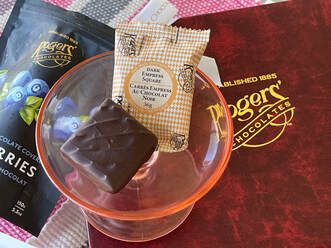
Another old family-owned chocolate company we discovered in our travels is Rogers’ Chocolates of Victoria, Canada. Victoria itself is an Afternoon Tea lover’s paradise with the Empress Hotel as the standard bearer of Afternoon Tea as it was meant to be. Murchie’s Fine Tea and Coffee is another charmer, where visitors are treated to perfect scones, tea sandwiches and sweets in the traditional English style. Just a few steps away from Murchie’s is Rogers’ Chocolates. Wayne and I wandered into this quaint old-fashioned candy store right on Government Street, the main street of Victoria, on our first visit to this charming town. We sampled Rogers’ signature chocolate, Victoria Cream, a luscious dark chocolate with a buttery vanilla center, and fell in love.
Little did we know on this first visit, that Rogers’ is the oldest candy store in Canada and still the leading gourmet candy maker in the country, founded in 1885 by Charles “Candy” Rogers. Charles Rogers originally sold a few chocolates in his grocery store but expanded to the present shop because his chocolates were so much more popular than the vegetables. Today, Rogers’ sells fine quality chocolates made from Fair Trade Certified Cocoa and provides world-wide shipping. The inventory is ever-changing to appeal to contemporary tastes. Our favorite is the iconic Empress Square, a perfectly textured dark chocolate filled with roasted almonds and caramel. A Sea Salt version of the Empress Square is also available. I don’t mind telling you that I have three boxes of Empress Squares in my refrigerator at this moment, shipped in perfect condition from Victoria to Hawaii as a birthday gift from Wayne.
Wayne phoned Ortrud immediately. She told him, with what seemed at the time as typical “New York rudeness,” that it was too much trouble to ship her chocolates all the way to California and she didn’t have time for him. “Goodbye.” But at the last moment, Ortrud suggested that Wayne could send a friend over to her studio to pick up his order and have that person mail the chocolates to him. Wayne thought about the only person we know who lives in New York City, my cousin, Nell Snaidas.
Nell’s husband, Tom Fervoy, answered the phone and was intrigued at the prospect of discovering the “…nation’s best chocolates.” When Tom arrived at her studio, Ortrud was much more charming to Tom than she had been to Wayne. A chat ensued, and Ortrud mentioned her love for opera. When Tom replied that his wife was an opera singer, it turned out that Ortrud knew Nell’s work and was a fan. From then on, both Tom and Wayne were on Ortrud’s good list, and Ortrud was happy to take all of Wayne’s orders and ship them herself. Nell’s glorious mezzo-soprano voice saved the day! Thanks, Nellie!
Ortrud’s chocolates really were the best we had ever eaten. The texture was perfect—not too hard and crunchy and not soft and messy. They created an ideal bite in the mouth, slowly melting on the tongue. They were not too sweet, and the deep, rich complex cocoa flavor was not adulterated with any of the dreaded additives found in the popular chocolate candies of our youth. A Hershey’s Milk Chocolate Bar, for example, contains, in order of volume: sugar, milk, chocolate, lactose, milk fat, soy lecithin, PGPR (what is that?) emulsifier, vanillin (an artificial flavoring,) and artificial flavor (presumably in addition to vanillin.)
For a few happy years, Wayne and I were in chocolate heaven, enjoying Ortrud’s perfect chocolates, some enhanced with roasted almonds, some with dried fruits and some pure, sublime chocolate. We were heartbroken when Wayne called one day to order more chocolates and was informed that Ortrud had died. After this devasting blow, Wayne became a Chocolate Detective, searching for chocolates that might be almost as good as Ortrud’s. Wayne discovered several excellent and innovative gourmet chocolate makers that were willing to ship their precious wares to arrive in perfect condition. Here are a few of our new favorites, all of which we have personally sampled:
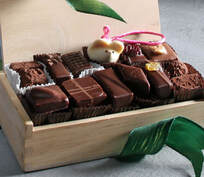
Founded in 1987 by Larry Burdick, an American who was trained in Switzerland, this Walpole, New Hampshire-based fine chocolate company produces innovative and high-quality chocolate delights with an emphasis on the seasons and the holidays. Burdick’s signature item is Chocolate Mice, adorable little creatures with sliced-almond ears, chocolate covered, of course, and cute little silk ribbon tails that can be used like lollipop sticks to hold the mice as you devour them. Newer additions to the Burdick inventory include Chocolate Elephants and Chocolate Penguins, in white and dark chocolate. Most of the L. A. Burdick Chocolate shops are on the Eastern Seaboard, including Boston, Washington, D.C., New York City and Cambridge, Massachusetts, but anyone can shop from their attractive website, which includes creative gifts, at a range of prices, such as a single Dark Chocolate Elephant for $6, a Gourmet S’mores Kit, for $38, or a Connoisseur’s Collection, including a wide variety of chocolates for $140.

John and Kira’s Chocolates
One of our favorite chocolate makers, John and Kira’s was founded in Philadelphia in 2002 by John Doyle and Kira Baker Doyle. This chocolate company specializes in unique flavors sourced from herbs and spices grown on family farms. Their best-selling Every Flavor Chocolate Box includes fifteen luscious pieces of dark chocolate ganache in flavors such as star anise, bergamot, whiskey, lavender and ginger from a family farm on the Hawaiian island of Molokai.
John and Kira’s also features whimsical Chocolate Honey Caramel Bees and Chocolate Ladybugs, filled with almond and hazelnut praline filling. Both of these sweet little chocolate insects are brightly decorated in yellow, red and black to resemble the creatures who inspired them. But our favorite John and Kira creation is the Chocolate Fig, a brilliant pairing of Spanish Figs, filled with whiskey flavored ganache and dipped in dark chocolate. You can order these rare delights in boxes of 12 for $39.95, or splurge on a Fig Tower Grande, 12 Chocolate Figs and a 28-piece box of Every Flavor Chocolates for $90. I have discovered that a single Chocolate Fig is a deeply satisfying treat, enjoyed at sunset, surrounded by the sounds of twilight and reflections of the day that is coming to an end.
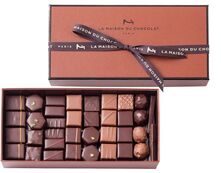
La Maison du Chocolate
This French chocolate chain, now world-wide, creates their chocolates by hand in their factory in Nanterre, near Paris. They produce tiny, bite-sized chocolates packaged in charming little brown boxes tied with chocolate-brown bows. The small size of each individual chocolate allows chocolate lovers to sample a variety of flavors in a single sitting without over-indulgence. La Maison du Chocolate specializes in a wide array of chocolate candies, pastries and treats, including truffles, fruit flavored chocolates and even divine little bites of dark chocolate-covered candied orange peel. So good!

Z Chocolat
This artisanal French chocolate company was founded in 2000 by Jean-Philippe Khodara in Forcalquier, Provence. Unfortunately, their headquarters and manufacturing facility were burned to the ground in May of this year, and they will not be able to fill orders until about mid-September. As a gesture of good will to their loyal customers, they plan to double each order at no additional cost. They are accepting orders now.
I have eaten many Z chocolates and find them truly exceptional. They contain no alcohol, no preservatives, low sugar, high cocoa content and 100% pure cocoa butter, originating in a variety of growing areas, including Venezuela, the Ivory Coast and Madagascar. Each of their twenty-four uniquely flavored chocolates is created in the same flattened pyramid shape and numbered, except their signature chocolate: Z. These extra special Z chocolates are filled with roasted hazelnut praline and sweet-salty caramel and covered in either dark chocolate, milk chocolate or white chocolate.
Every order of Z Chocolat arrives in excellent condition in a cute little drawstring bag containing the chocolates and a little black book describing each chocolate in minute detail, including the origin of every ingredient, calorie, sugar, salt, fat and protein content and even possible allergens. One of my favorites is #13, “A rich and smooth cinnamon ganache drenched in Venezuelan and Madagascan blend 70% dark chocolate.”
September brings a kind of wistfulness to the air as summer comes to an end and autumn looms. This is the season when we realize that the holidays are right around the corner, and we are way behind in our planning. Once again, Chocolate is here to save us. Since fine quality artisanal chocolate is never a disappointment, Afternoon Tea guests will welcome a few of John and Kira’s Chocolate Honey Caramel Bees along with the traditional Shortbread on an attractive tiered server, or perhaps even some of Z Chocolat’s Pates de Fruits (100% natural fruit jellies from Provence in cherry, orange, lemon or apricot) on the table near the Scones, the Devonshire Cream and the Lemon Curd.
For an intimate and festive dinner, Burdick’s elegant but diminutive 6-inch Chocolate Cakes provide the perfect conclusion to a special occasion meal for four. The Chocolate Raspberry Cake would delight your guests, as would the Chocolate Lemon Cake or the Earl Gray Mousse Cake, all priced between $38 and $48. Gourmet Chocolates are also much appreciated hostess gifts or party favors. If every child at a birthday party found a Burdick’s Chocolate penguin, mouse, or elephant, or a John and Kira’s ladybug next to their slice of birthday cake, how happy they would be! And at a Christmas, Thanksgiving or New Year’s Eve dinner, a Rogers’ Chocolate Empress Square, still neatly wrapped, next to each place setting, would add a new level of holiday cheer.
If you choose to include Artisanal Chocolates in your home entertaining, be sure to serve them at room temperature. Fine Chocolates should be kept at a cool and dry room temperature, like a wine cellar, but here in Hawaii, where rooms can become very warm, I refrigerate my chocolates and let them come to room temperature for about half an hour before serving them. If you are offering assorted chocolates, do not leave them in the box. They deserve to be placed in beautiful candy dishes, bowls or serving trays like any other elegant dessert. You may leave them in their paper candy cups if you wish, and if they are individually wrapped, as Empress Squares are, leave them in their wrappers but place the wrapped candies in an attractive dish.
For Christmas and other Holiday gifts, there is nothing like a box of candy. Think about what your recipient really likes and try to avoid any ingredients that may be allergens. In California, showing up with a two-pound box of See’s Dark Chocolate Nuts and Chews guarantees a hearty welcome. If you are not sure what to give, all the candy companies I have discussed have beautiful websites with an amazing array of chocolate gifts for any occasion, gifts you may never have dreamed of! Let the innovation, expertise and genuine love of these dedicated chocolatiers inspire you. Your friends will love you for it!











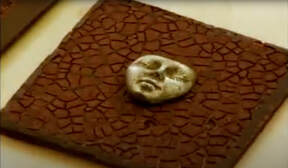
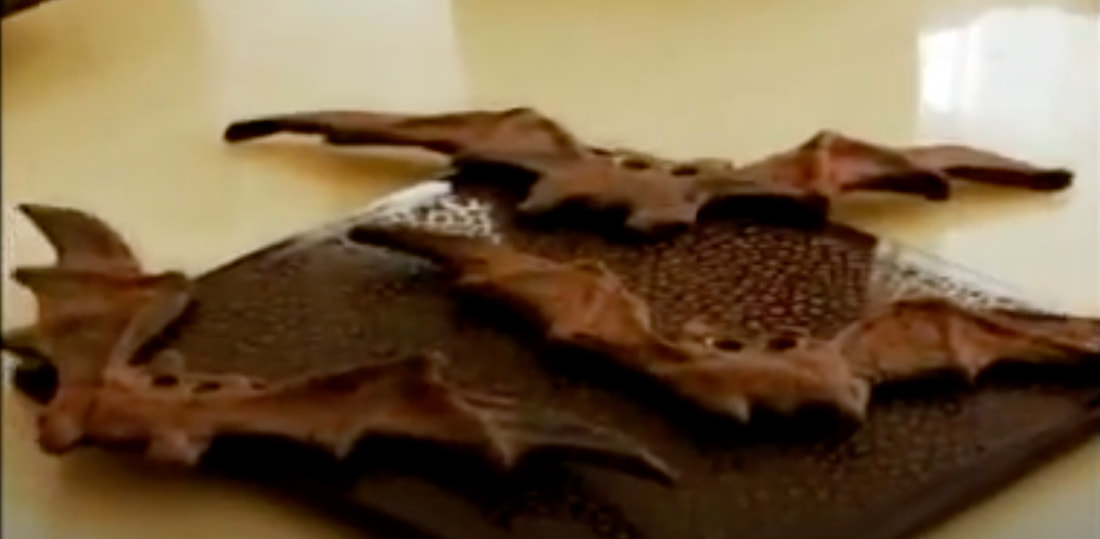




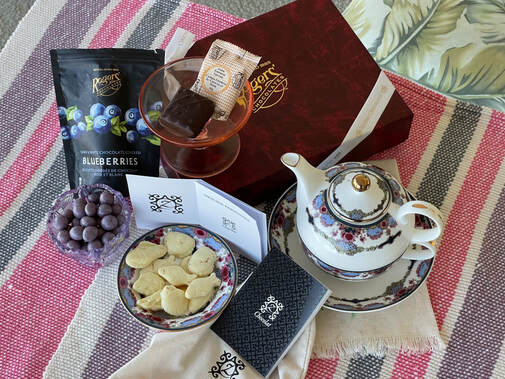
 RSS Feed
RSS Feed